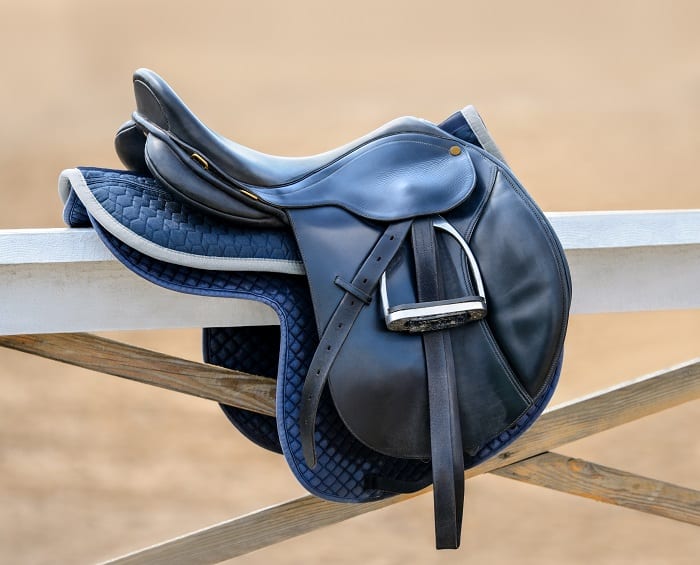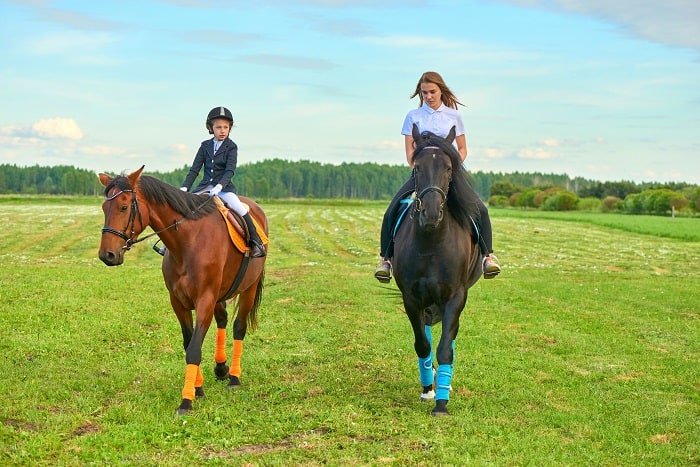Last Updated on December 1, 2021
Sometimes when I tell people I ride horses, they think I’m a cowboy, and other times they think I’m a jockey! The English vs Western riding confusion is one that nearly every non-horsey person can relate to. What’s the difference and why does it matter?
There are many, many differences between English and Western styles of riding, starting all the way back to the reason why each style was created. I will be talking about the most prominent of these issues today.
In this article, I will be discussing the differences in the origins of the English and Western disciplines, the differences in tack between the two, the unique disciplines that use each style of riding, and the differences in breeds of horses that are most suited for each style.
English vs Western Riding
Origins
English saddles can be seen, in some form or another, all the way back to medieval times. No, these saddles don’t nearly look like English saddles do today, but they are where our modern saddles got their origin.
As English saddles evolved, they served the purpose of sitting the rider upright, mainly for looks and appearances. Eventually, as equine sports arrived on the scene, they served other purposes, such as being thin enough for the horse to be able to feel subtle pressures and adjustments from the rider’s legs.
Today, different types of English saddles accomplish different purposes, including holding the rider’s leg in the correct position, keeping the rider’s seat in the middle of the horse’s back, and keeping the pressure directly off the horse’s spine.
Western saddles were first seen in colonial western America. They were created with the purpose of keeping the rider comfortable and at ease during long rides, often over rough terrain.
Today, Western saddles are still used for this purpose, frequently as trail riding saddles. They are also used in other Western disciplines, which embody what “cowboys” long ago would have had to do for survival purposes.
English vs Western Riding: Tack
There are many differences in English and Western tack, but the easiest to identify are the saddles. Western saddles are big, often have flat bottoms lined with a soft material, have horns (like a handle on the front of the saddle), have thick stirrup leathers, and have wooden or plastic stirrups.
Western saddles are frequently decorated with designs in the leather and other embellishments such as silver plating and leather frills.
English saddles are small, only covering where the rider’s leg and seat will go when riding the horse. They have a two-paneled bottom, made of the same material as the rest of the saddle. There is no horn on the front, and no designs in the leather or other embellishments, except for many a nameplate on the back, if it is a personally owned saddle.
Another notable difference is the bridle. Western bridles frequently do not have nosebands or browbands, which are considered staples of the English bridle. These bridles also sometimes utilize rope reins, where English reins are always leather or rubber.
Western riders also use a different type of splint boot, or tendon boot, than English riders. Western riders typically use a type of foam wrap, while English riders typically use cotton polo wraps or leather splint boots.
English vs Western Riding: Disciplines
English riding and Western riding have very different competitive disciplines. Western riding is used for disciplines like reining, cutting, barrel racing, and western pleasure. Reining and cutting are used to emulate important skills that horses must have when working with cows.
Barrel racing is a fun speed event, mostly popularized by cowgirls, and western pleasure is a discipline that hopes to showcase the ideal gaits and demeanor of a pleasure horse. Western tack is used in all of these disciplines, and bright flashy colors and sequins are common to see.
English riding is used for disciplines like dressage, hunter/jumper, equitation, eventing, and show jumping. All of these disciplines, except dressage, involve jumping. And, all of these disciplines (except for the cross country phase of eventing), involve a very conservative dress code.
Breeds
There are also different breeds of horses that are suitable for these different types of riding. For example, the Quarter Horse is known for being an extremely popular western mount. Think about why this may be, in terms of physical characteristics.
Quarter Horses are known for having a wide back and barrel, perfect for supporting the wide, flat bottom of a Western saddle. They are also known for being on the stockier side, frequently found with shorter legs. This keeps them closer to the ground, where they can more effectively complete the quick movements. This is required from disciplines like cutting and reining.
On the other hand, Thoroughbreds are a popular breed in the English world. They are used most prominently for racing, and then later repurposed for disciplines like dressage, hunter/jumper, and eventing.
Thoroughbreds are quick on their feet, which makes them ideal for timed events. Events like racing, eventing, and show jumping or jumpers. They are also athletic enough to be successful in disciplines like dressage and equitation or hunters.
It is important though to understand that while there are breeds that are more common to find in each style of riding, any breed of horse can compete in any discipline. There are Quarter Horses that have been extremely successful in the hunter ring and in eventing.
And, I’m sure there are Thoroughbreds that have been great Western Pleasure horses, or even great trail horses. It all depends on the horse, how it was trained, and how it was maintained throughout its lifetime.
Conclusion
There are many differences between English and Western riding, and both styles have accomplished great things and produced incredible horses and riders over the years.
I hope this article helped you learn more about the differences between the two styles. May it helped you learn their purposes, their tack, and their disciplines. If so, please share this article, and share with us your experiences in both disciplines!
FAQs
Is English or Western riding easier?
This is a question that many riders ask themselves, and the answer is not always clear. There are pros and cons to both styles of riding, but in the end, it comes down to what each rider prefers.
English riding is often seen as more formal and disciplined than Western riding. It requires more precision and focus and can be more challenging for a beginner. Western riding is more relaxed and fluid and can be a little less precise. It is often seen as being easier to learn, and more forgiving if you make a mistake.
Ultimately, the choice between English or Western riding comes down to personal preference. Some riders feel more comfortable in English tack, while others prefer the freedom of Western saddles.
Do Western riders post the trot?
Posting the trot is a technique that was developed in English riding, and is used to improve the horse's gaits. It involves rising out of the saddle and landing on the same spot over and over again.
The western style of riding is looser and more free-flowing than English, so there is no need to post the trot. A western saddle has a solid seat that supports the rider's weight evenly, allowing them to ride with minimal movement. However, the trot is an important gait that helps the rider cover long distances quickly and for that reason is sometimes also used in western riding.
Is an American Paint Horse associated with Western riding?
Yes. The American Paint Horse is a western riding horse breed that developed in the early 1900s by crossing American Quarter Horses with Thoroughbreds, Morgans, and Mustangs. American Paint Horses are known for their agility, speed, and endurance. They are used for all sorts of western riding disciplines, including trail riding, western pleasure, and reining.
Do Western riders use spurs?
Spurs are not used as commonly in western riding as they are in English riding. However, some western riders do use spurs, especially in disciplines such as reining and barrel racing. Spurs are used to help the horse move more quickly and smoothly and can be very effective when used correctly. However, it is important to remember that spurs should only be used when needed, and should never be used as a way to punish the horse.
Western riders often prefer the use of leg aids, such as tapping with your heels, over spurs. Leg or "tap" cues are just another form of communication between horse and rider that is common in western style riding and also seen as more humane.
Is English riding the same as dressage?
Technically speaking, no. English riding includes dressage, but it encompasses all english riding disciplines including show jumping and eventing. The goal of english riding is to have the horse perform fluid figures with an even rhythm over ground poles or fences while being ridden.
Dressage is one part of english riding and involves training the horse in a series of predetermined movements. It is all about "what the horse does with his legs and where his feet are".
Dressage is a highly technical, challenging discipline that requires great training and focus from both the rider and the horse. It has become its own sport, separate from english riding in general, and can be seen at international competitions such as the Olympics.
Michael Dehaan is a passionate horse owner, horse rider, and lover of all things equine. He has been around horses since he was a child, and has grown to become an expert in the field. He has owned and ridden a variety of horses of different breeds, and has trained many to compete in shows and competitions. He is an experienced horseman, having worked with and competed many horses, including his own. He is an active member of the equestrian community, participating in events and teaching riding lessons.


